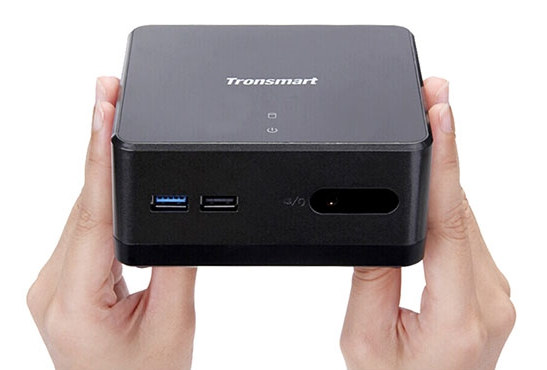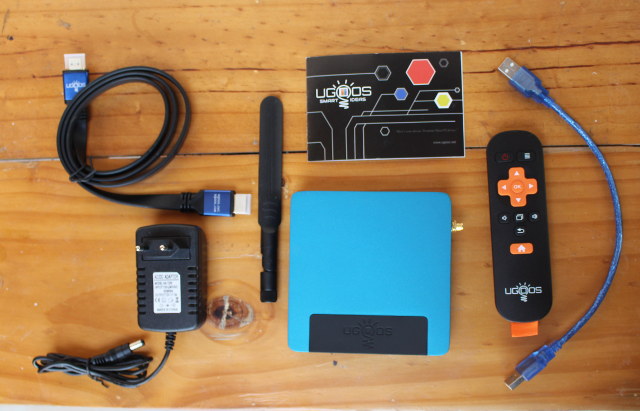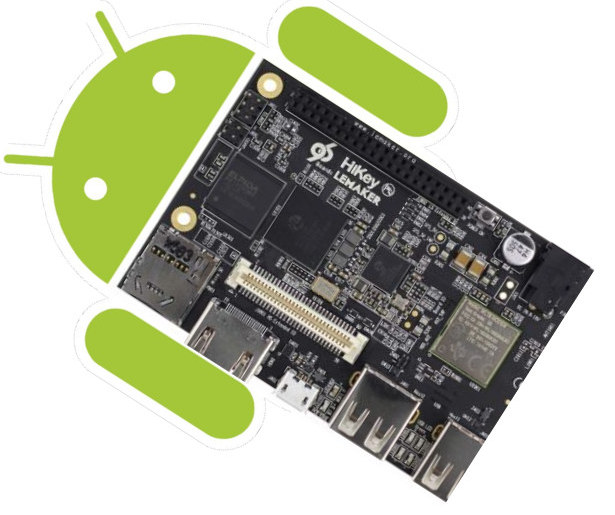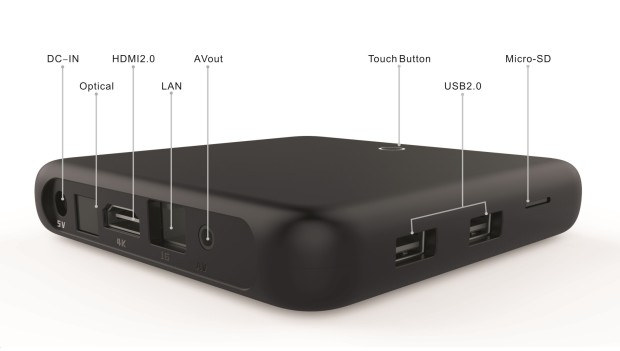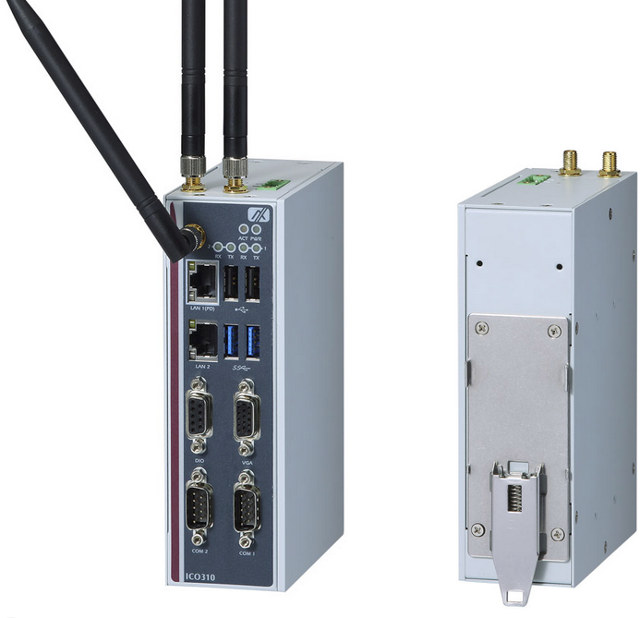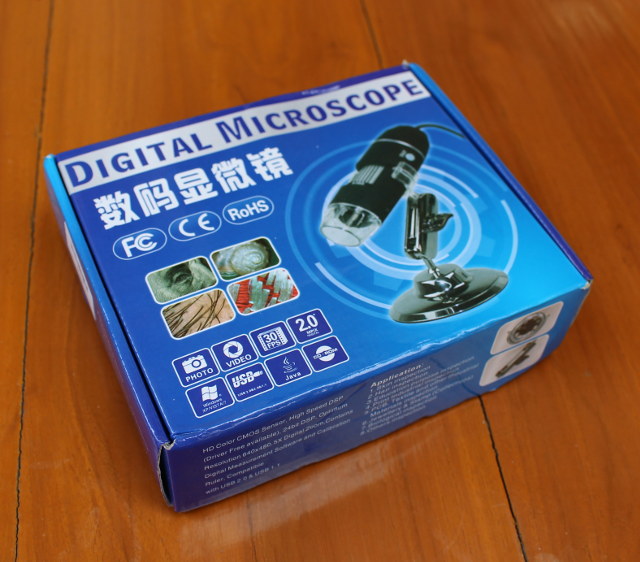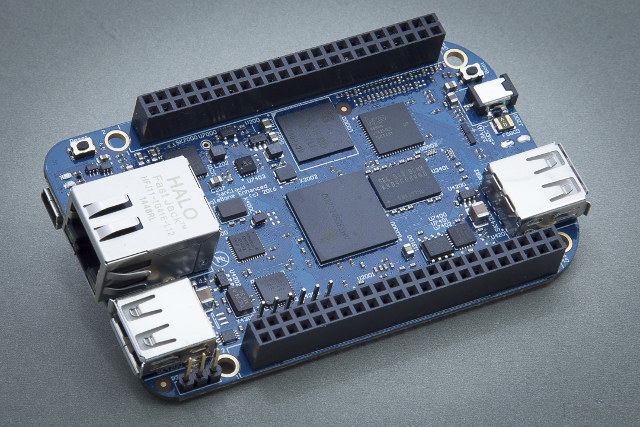Tronsmart BJ19 is a barebone mini PC powered by Intel Celeron J1900 quad core “Bay Trail-D” processor with SO-DIMM slots for memory, and a SATA interface for a 2.5″ hard drive or SSD in a form factor similar to Intel NUC. It was launched last year, but GeekBuying is probably getting rid of stock, as it is selling it for just $59.99 shipped. Let’s remind us of the specs: SoC – Intel Celeron J1900 Quad core processor @ 2.0 GHz (base) / 2.41 GHz (burst) with Intel HD graphics (10W TDP) System Memory – DDR3L 1333/1666 MHz SO-DIMM slot Storage – 2.5″ SATA hard drive or SSD Video Output – mini HDMI + mini DisplayPort Audio – mini HDMI, 3.5 mm jack for headphone and MIC-in Connectivity – Gigabit Ethernet, mPCIe Wi-Fi (2.4GHz) and Bluetooth 4.0 module USB – 3x USB 2.0 host ports, 1x USB 3.0 port. Misc – […]
Ugoos AM1 Android TV Box Giveaway
I reviewed Ugoos AM1 TV box based on Amlogic S905 processor a few weeks ago, and while the hardware was rather good, and found the firmware lacking with some bugs such as the remote control and one USB port not port, some instability issues with Google play and Kodi, Bluetooth transfer corruption, etc… The company has now released a firmware update (v 0.0.4) that will fix most of the issues I reported, and also sent me a new remote control as the one I had was an early model, and we’ve decided to giveaway one Ugoos AM1 to one lucky winner, the same way we had done for Ugoos UT4. The Rafflecopter form below has three options, each optional, but if you do all three you’ll get more chances to win. The contest will run for 4 days until March 16 10am (GMT+7), I’ll select the winner randomly through RaffleCopter, […]
96Boards Hikey Development Board is Now Officially Supported in AOSP
Hikey is a one of the first 96Boards compliant development board manufactured by either LeMaker in China and CircuitCo in the US, and while the hardware requirements of 96Boards specifications are rather easy to meet, the software requirements including “bootloader (open source), accelerated graphics support (binary or open source), a Linux kernel buildable from source code based from mainline, or the latest Google-supported Android kernel version” are much harder to comply with. Linaro had a very good news for Linaro Connect Bangkok as they announced Hikey board was supported in Android Open Source Project (AOSP). So that means Hikey board will run the latest version of Android like Google Nexus devices, with the advantage of also getting more recent devices. If you want to build an Android image from AOSP just retrieve the source code:
|
1 2 |
repo init -u https://android.googlesource.com/platform/manifest repo sync -j8 |
Grab & extract vendors binaries for Hikey from Google.com. and complete the build:
|
1 2 3 |
source build/envsetup.sh lunch hikey-userdebug make -j8 droidcore |
[…]
Unuiga S905 TV Box Runs Remix OS 2.0 on Amlogic S905 Processor (Crowdfunding)
There are many Android TV boxes based on Amlogic S905 processor on the market selling for as low as $40 shipped, and hardware-wise Unuiga S905 and S905+ TV boxes look quite similar to their competitors with respectively 1GB RAM and 16GB flash, and 2GB RAM and 32GB flash, but the main differentiating factor is official support for Remix OS 2.0. Unuiga S905 and S905+ specifications: SoC – Amlogic S905 quad core ARM Cortex-A53 @ up to 2.0GHz with penta-core Mali-450MP GPU System Memory – S905: 1GB RAM; S905+: 2GB RAM Storage – micro SD slot; S905: 16GB flash, S905+: 32GB flash Video Output – HDMI 2.0, AV Audio – HDMI, AV, coaxial S/PDIF Connectivity Gigabit Ethernet WiFi – S905: 802.11 b/g/n; S905+: dual band 802.11 b/g/n/ac Bluetooth 4.1 (according to comment on YouTube) USB – 2x USB 2.0 host ports Misc – IR receiver, touch button for power on/off and […]
Axiomtek ICO310 Din-rail Industrial IoT Gateway Supports Power over Ethernet (PoE)
Axiomtek ICO310 is a din-rail IIoT (Industrial IoT) embedded platform powered by Intel Celeron Braswell processors supporting up to 8GB RAM, PoE, and featuring two Gigabit LAN ports, RS-232/422/485 ports, USB 2.0 & USB 3.0 ports, one VGA port, and one DIO interface. It also support mSATA and SATA drives, and wireless module via mPCIe interfaces. Target applications include smart energy, smart factory automation, facility monitoring systems and more. Axiomtek ICO310 Specifications: SoC Intel Celeron N3060 dual core processor @ 1.6GHz / 2.48 GHz (Turbo) with Intel HD graphics 400 with 12EU @ 320/600 MHz OR Intel Celeron N3160 quad core processor @ 1.6GHz / 2.24 GHz (Turbo) with Intel HD graphics 400 with 12EU @ 320/640 MHz System Memory – 204-pin SO-DIMM DDR3L-1600 socket up to 8 GB Storage – 1 x mSATA, 1x SATA SSD (or HDD) Video Output – VGA Connectivity 2x 10/100/1000Mbps Ethernet, including 1x PoE PD […]
Using a Cheap USB Microscope To Read IC Part Numbers
It’s not always easy to read the part number on IC you find on boards, and some time ago, I watched a video where Lady Ada used a USB microscope to demonstrate how to solder some components, and probably using that 5.0 MP model sold on Adafruit for about $80. But I found a similar looking USB microscope with a 2.0MP sensor and 1000X magnification on Ebay for $16.59 shipped, so I bought it, received it today, and I’ve given it a try. Such microscopes can be used to inspect skin and hair, PCB, textile, bank notes, jewelery, and so on. There are apparently other models based on the one I purchased with useful features like auto-focus, wireless support, different levels of magnification, and different colors. Supported operating systems include Windows and Linux, Android, and Windows 8 according to the package. The microscope comes with a stand, a CDROM with […]
BeagleBone Enhanced Adds Gigabit Ethernet, More Memory & USB Ports, and Sensors (Crowdfunding)
It’s nice to see BeagleBone Black‘s open source hardware being leveraged by third parties, as we’ve already seen designs such as BeagleBone Green and BeagleBone Black Industrial 4G in the past, and now UK based SanCloud has decided to launch BeagleBone Enhanced on Indiegogo (flexible funding). BeagleBone Enhanced board specifications with bold highlights showing improvements over the BeagleBone Black Rev. C: SoC – Texas Instruments Sitara AM3358 Cortex A8 @ 1 GHz + PowerVR SGX530 GPU System Memory – 1GB DDR3 RAM @ 800 MHz Storage – 4GB eMMC flash + micro SD slot, optional 1MB SPI NOR flash USB – 2x USB 2.0 host port (A type), mini USB OTG port, 2x USB interfaces via expansion header Serial Port – UART0 via 3.3V TTL header Ethernet – Gigabit Ethernet Video Output – micro HDMI with EDID support, up to 1280×1024 resolution. Audio Output – Via HDMI Sensors Optional 6 […]
Android N Developer Preview Released with Multi-Window Support, PiP, Background Apps Optimizations…
Google has just released an early developer preview of Android 7.0 N (Nutella?) before the OS officially launched later this summer with new features such s multi-window support, TV recording, Picture-in-picture, bundled notifications, and efficiency improvements. So let’s have a look at some of improvements: Multi-window – A new manifest attribute called android:resizableActivity is available for apps targeting N and beyond, allowing your activity to be launched in split-screen modes on phones and tablets. In addition, activities can also go into picture-in-picture mode on devices like TVs by setting android:supportsPictureInPicture to true. Direct reply notifications: Initially an Android Wear only features, the RemoteInput notification API has now been added for smartphones and tablets, and allows user to reply directly within the notification shade. Bundled notifications – The Notification.Builder.setGroup() method can be used to bundle notifications from the same app together. Efficiency Improvements – Doze has been further improved to save […]


